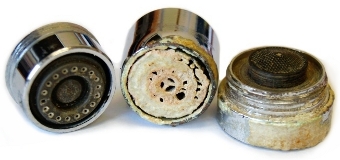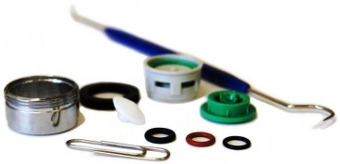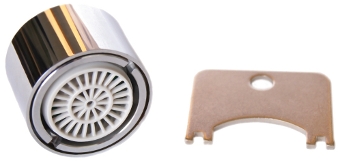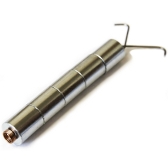Limescale Protection prevent the build-up of Calcium and other minerals from water on the product. Standard aerators have to be cleaned regularly to dispose of the Calcium deposits. Even if standard aerators are cleaned twice a year, it is near-impossible to prevent corrosion on the metal mash inside the aerator. Our WATERSAVERS® products consist of parts made from high-quality plastic materials, that are resistant to water chemicals as well as hot water. These high-quality materials are designed to withstand high-temperatures up to 354 °F (179 °C).
Water Savers
WATERSAVERS® products are made for three different functions – sink faucets, showers and toilets. All products are made from only high-quality materials and are manually assembled in the Czech Republic. Our products have all the necessary certificates and have been thoroughly tested. Our products prevent the build-up of Calcium deposits and are the only water-savers in the world with adjustable limitations on water-volume.
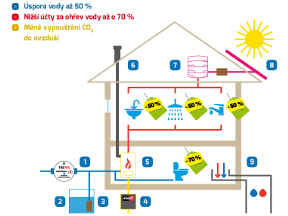
Water Savers for Kitchen and Bathroom Sink Faucets
Faucet water savers are installed on the end of the faucet nozzle, in the same was a basic aerator would be installed. Usually an existing corroded aerator or an aerator with build-up deposits would be replaced by our WATERSAVERS® faucet aerator. The standard water-flow rate of a WATERSAVERS® faucet aerator is set to 1.5 gallons per minute (gal/min) and can be changed at any time to 1, 1.5, 2, 2.5, 3 or 3.5 gal/min. Due to a unique water flow system, you will not notice the difference in the volume of water.
The difference between WATERSAVERS® aerators and standard aerators
A standard aerator is made to allow all the water pass through as quickly as possible. The volume of water used usually ranges from 4 to 5 gallons per minute, based on water pressure. Even when a standard aerator is regularly cleaned, it is impossible to prevent the build-up of deposits on the aerator mash which cause corrosion in about 2 years. The aerator must then be replaced because a corroded aerator may contain harmful bacteria that could contaminate your water with Legionella pneumophila bacteria, which could lead to life—threatening Legionnaires' disease.
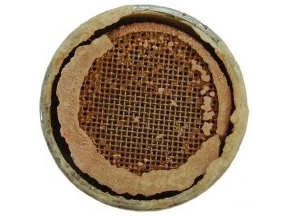
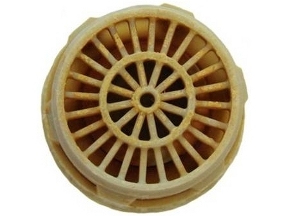
The difference between standard (left) and WATERSAVERS® aerator after 3 years of use.
You should know that:
Warranty on regular aerators usually lasts 1-2 years, the lifecycle is about 3 years. Lifecycle of our water-savers is over 20 years and the warranty lasts for 5 years.
The difference between WATERSAVERS® and other brands saving aerator
Water aerators offered by other brands have a fixed water flow and cannot be changed or adjusted. Because most aerators are made out of metallic materials, they corrode in the same way a standard aerator does which may lead to harmful bacteria contaminating the water. Usually, after dismounting and disassembling a standard aerator for cleaning purposes, it can be extremely difficult to assemble and mount the aerator back on the faucet. Also, the manufacturers’ flow rate is usually a prediction as not much research has been put in, when designing the product. The warranty of a standard aerator is usually 1-2 years.
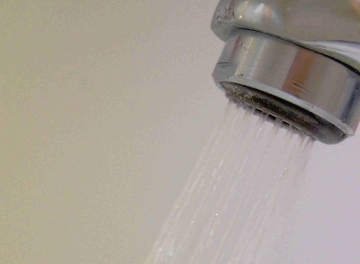
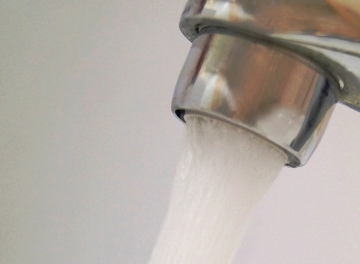
Comparison of water flow coming out of another brand aerator (left) and our WATERSAVERS® aerator with the same water flow rate, set to 1.5 gallons per minute.
WATERSAVERS® aerators are very easy to maintain
Maintenance is quite simple. Every once in a while, rinse out the white plastic sieve that catches larger particles. It is recommended that you clean the sieve when water flow has decreased or just once every 6 months. The amount of particles caught in the sieve depend on the water quality.
Cleaning Instructions — unscrew the aerator from the faucet, remove and rinse the white sieve, put it back in its place and screw the aerator back on to the faucet.
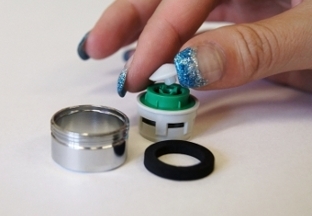
A set of silicon rings are provided with each aerator. Each ring has a different thickness and color. The water flow rate can be adjusted by removing or adding a ring(s), already in-place inside the aerator.
For example 2 gal/min — 1x red O-ring.
Water Savers for Showers
They are made out of the same high-quality materials as our faucet water-savers. Our products meet or exceed all of the sanitary requirements and regulations; they are anti-Limestone and the maximum-flow ratio has been certified through laboratory testing. The new product is set to limit the water volume to 2.5 gallons per minute. Like the faucet water-savers, the volume of water can be adjusted to limit the maximum-volume to 1.5, 2, 2.5, 3 or 3.5 gal/min at the user’s pleasure.
Because less hot water will be used, you will save money on costs for heating the water up.
A set of silicon rings are provided with each aerator. Each ring has a different thickness and color. The water flow rate can be adjusted by removing or adding a ring(s), already in-place inside the aerator.
For example: A water flow of 2 gal/min — 1x red O-ring.
Our shower hoses
Apart from shower water-savers, we also offer high-quality shower hoses – with or without a built in water-saver. These unique products will not break and can withstand high pressures. They can also stretch to reach any spot while in the shower.
- Ideal for all types of shower systems.
- Made out of high quality chrome-plated brass to withstand high pressures.
- The standard length is 60 inches; can be stretched up to almost 80 inches.
- Both ends are robust conical nuts.
- Standard 1/2" size.
- Can withstand a pulling force of up to 110 lbs, inside pressure up to 10 atm. (147 PSI) and temperature 34–194 °F.
- 2 years warranty.
Toilet Water Savers
Toilet water-savers are ideal for all classic- and/or two-button toilets. Water volume is adjusted by adding or removing the stainless steel cylinders, that also prevents leakage.
With each toilet flush, about 2.5 gallons of water is wasted. In a household with 4 people, an average of 70 gallons of water is flushed out daily, which adds up to 25,550 gallons per year costing about $250. That is double the volume of a regular sized home pool, wasted every year. When using toilet reservoir-saver, up to 70% of the water will be saved, which would result in household savings of about $175 per year only on toilet use.

